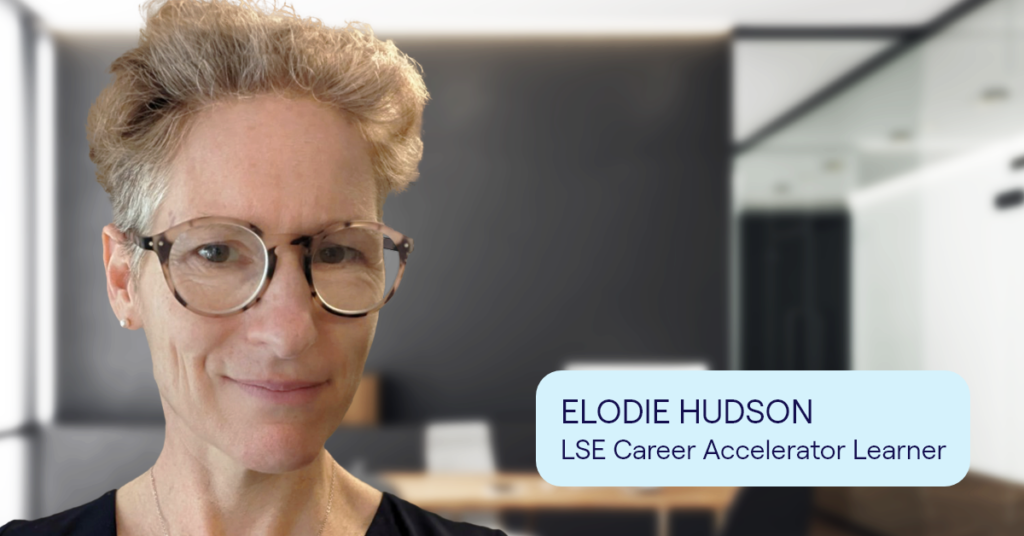
After completing her bachelor’s degree in architecture, Aman realised that it wasn’t the right career path for her. She got a job working as a PowerPoint designer, and it was through that that she was introduced to aspects of user experience (UX) design. She launched into researching what a career in UX might look like, and that’s when she found the King’s UX Design Career Accelerator.
I felt this Career Accelerator would lay a foundation for launching my career
“I did my bachelor’s degree in architecture. After I did that, I kind of realised that it wasn’t the career for me, and so I was essentially starting from scratch. I managed to get a job as a PowerPoint Designer at a healthcare company, and through that I was introduced to UX and some of the principles. It piqued my interest, so I did some research, came across this course, and kind of began my UX career from there.”
The Career Accelerator allows you to build a comprehensive portfolio as you learn
“I think the course is structured really well in the sense that it breaks down different aspects of UX design in a way that allows you to build quite a comprehensive portfolio as you go along. And that really helped with job interviews and things like that.”
My Success Manager and Career Coach were invaluable
“My Success Manager was really helpful to just chat to about how I was getting along with the course and speak about what I was worried about, or what I needed help with and kind of gain more clarity. And then, alongside that, the Career Coach was really helpful in prepping me for interviews, telling me what I was doing right and also what I needed to improve on, and just helping to build my confidence because I think that was personally something I was lacking when I first joined. To have that mentorship was really valuable.”
I felt supported every step of the way
“I think Course One is where you kind of figure out what works best for you. It’s flexible, which is useful. If you’re struggling, I recommend just talking with your Success Manager because they can really help you figure out your routine, give you the confidence and say, “Look, you know, this might help here, or why don’t you try this?” And it’s nice to have someone to talk to when you’re feeling a bit overwhelmed.”
It’s an interactive learning experience with tutors and peers
“Alongside the career coaching, having the Success Manager as someone you can talk to throughout the process is what made the programme stand out for me.”
“I really like the live sessions that we have weekly, which give us an opportunity to chat with the tutors and ask any questions we have. And I think the peer reviews are quite unique because it’s quite a good way to get everyone involved. We haven’t started yet, but I’m really looking forward to the Employer Project too. I think it’s a really good opportunity to get some real-life experience and see how it would work in the real world.”
I got a job after only four months on the programme
“I was able to land something within four months of starting the course. And I’m now working at a separate healthcare company in their marketing department but as a UX designer.”
“We’re currently working on an eczema management app, which is great because much of what I’m doing is very similar to what is covered in the course.”
Each day, I’m learning something new
“Working as a UX designer means my day-to-day is very different, which I love. Each day I’m learning something new; I’m talking to different people; I’m working on something different, which is really fun.”

Elodie Hudson is another Career Accelerator learner who trusted her intuition and pursued a new career in what she was passionate about after working in the same industry for 16 years. Read her story here.
I’ve future-proofed my career with transferable soft skills
“So, I think in terms of competitiveness, the job market at the moment is just crazy for everyone, which is really unfortunate. A lot of people talk about AI and computers taking over. But I think the one thing they’re not really able to provide is that human empathy and interaction, which is quite crucial for UX because you’re thinking about how your user is going to feel or how you want their actual overall experience to be when using a product or an app or website. I’m quite confident in saying that I don’t think AI is going to take over anytime soon, which is great for us because we provide that kind of human connection.”
If you’re smart with your time, you can manage this programme while working full-time
“I’m working during the day, and then after work I’ll do at least two to three hours per evening. I think that’s the most I’ve been able to manage without feeling burnt out. And then, I try to dedicate at least one day a weekend just to go over everything. Obviously, towards the end of each course, that kind of picks up a bit and you do end up spending more time. But I think that would probably equate to 15 to 18 hours per week, roughly.”
We’re excited to follow Aman’s growth as she continues to develop in her new UX design career. She recently joined us at a webinar to share more about her learning journey and experience working as a UX designer. You can watch the recording here.
If you’re interested in exploring whether the King’s UX Design Career Accelerator can help you change your career track, check out the programme page.



